Service Recovery in the Restaurant Industry Case Study
VerifiedAdded on 2023/06/04
|9
|2355
|59
AI Summary
This report provides an in-depth analysis of a service failure incident and recommends related service recovery strategies in the restaurant industry. The report discusses the failures in service delivery, quality of food, staff behavior, and service recovery attempts. The report recommends strategies to improve service timing accuracy, maintain restaurant equipment, train staff on customer handling, prioritize service recovery activities, and begin any service recovery attempts with an apology for the failure.
Contribute Materials
Your contribution can guide someone’s learning journey. Share your
documents today.
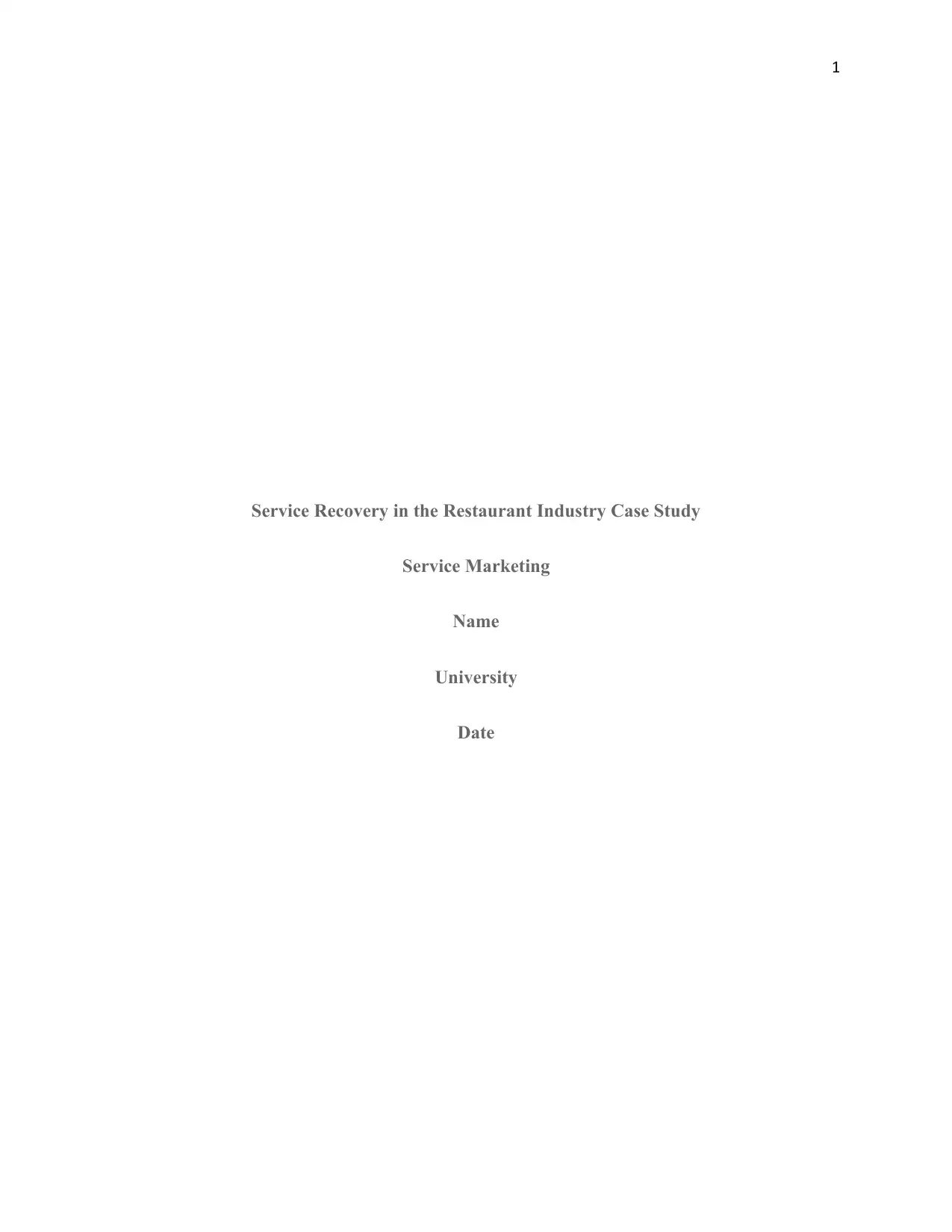
1
Service Recovery in the Restaurant Industry Case Study
Service Marketing
Name
University
Date
Service Recovery in the Restaurant Industry Case Study
Service Marketing
Name
University
Date
Secure Best Marks with AI Grader
Need help grading? Try our AI Grader for instant feedback on your assignments.
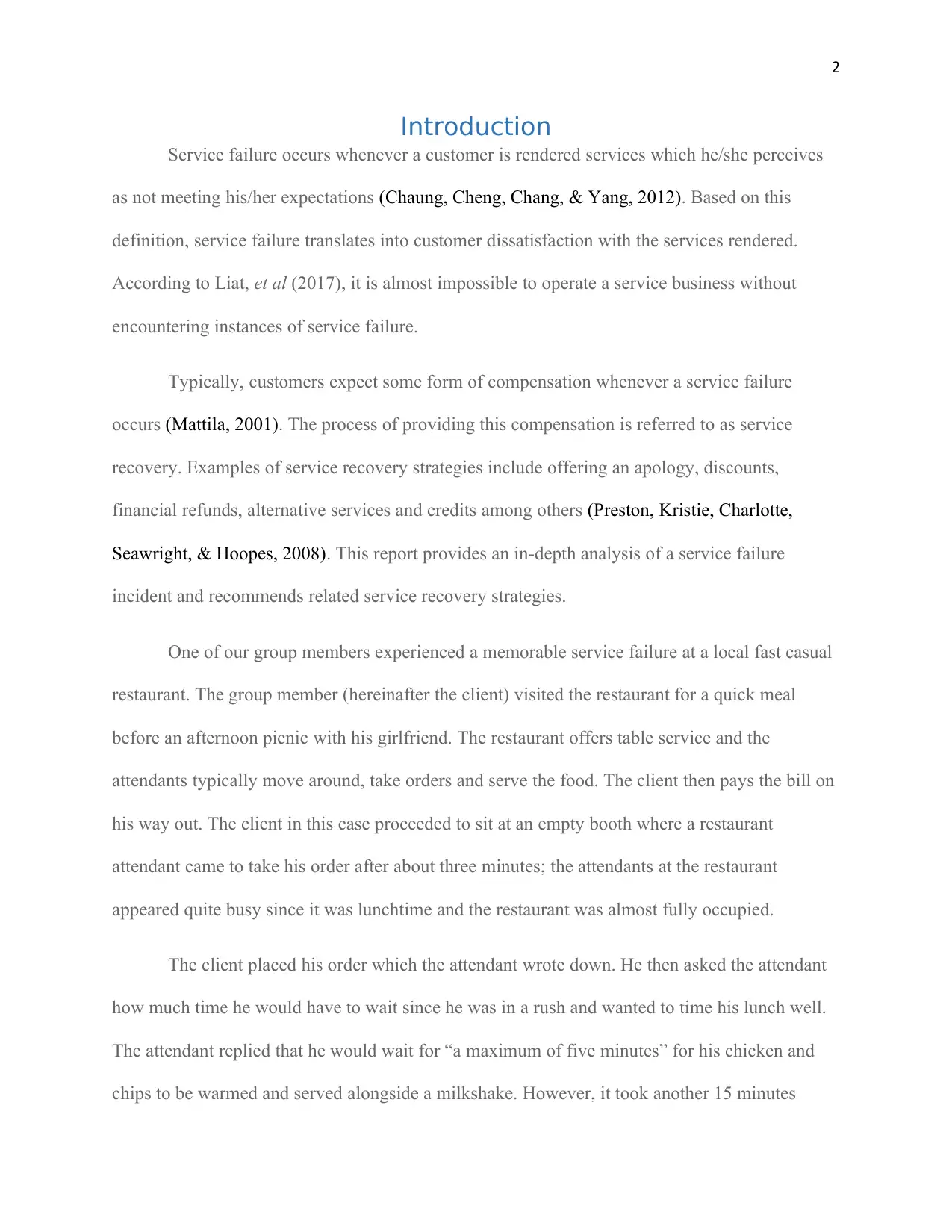
2
Introduction
Service failure occurs whenever a customer is rendered services which he/she perceives
as not meeting his/her expectations (Chaung, Cheng, Chang, & Yang, 2012). Based on this
definition, service failure translates into customer dissatisfaction with the services rendered.
According to Liat, et al (2017), it is almost impossible to operate a service business without
encountering instances of service failure.
Typically, customers expect some form of compensation whenever a service failure
occurs (Mattila, 2001). The process of providing this compensation is referred to as service
recovery. Examples of service recovery strategies include offering an apology, discounts,
financial refunds, alternative services and credits among others (Preston, Kristie, Charlotte,
Seawright, & Hoopes, 2008). This report provides an in-depth analysis of a service failure
incident and recommends related service recovery strategies.
One of our group members experienced a memorable service failure at a local fast casual
restaurant. The group member (hereinafter the client) visited the restaurant for a quick meal
before an afternoon picnic with his girlfriend. The restaurant offers table service and the
attendants typically move around, take orders and serve the food. The client then pays the bill on
his way out. The client in this case proceeded to sit at an empty booth where a restaurant
attendant came to take his order after about three minutes; the attendants at the restaurant
appeared quite busy since it was lunchtime and the restaurant was almost fully occupied.
The client placed his order which the attendant wrote down. He then asked the attendant
how much time he would have to wait since he was in a rush and wanted to time his lunch well.
The attendant replied that he would wait for “a maximum of five minutes” for his chicken and
chips to be warmed and served alongside a milkshake. However, it took another 15 minutes
Introduction
Service failure occurs whenever a customer is rendered services which he/she perceives
as not meeting his/her expectations (Chaung, Cheng, Chang, & Yang, 2012). Based on this
definition, service failure translates into customer dissatisfaction with the services rendered.
According to Liat, et al (2017), it is almost impossible to operate a service business without
encountering instances of service failure.
Typically, customers expect some form of compensation whenever a service failure
occurs (Mattila, 2001). The process of providing this compensation is referred to as service
recovery. Examples of service recovery strategies include offering an apology, discounts,
financial refunds, alternative services and credits among others (Preston, Kristie, Charlotte,
Seawright, & Hoopes, 2008). This report provides an in-depth analysis of a service failure
incident and recommends related service recovery strategies.
One of our group members experienced a memorable service failure at a local fast casual
restaurant. The group member (hereinafter the client) visited the restaurant for a quick meal
before an afternoon picnic with his girlfriend. The restaurant offers table service and the
attendants typically move around, take orders and serve the food. The client then pays the bill on
his way out. The client in this case proceeded to sit at an empty booth where a restaurant
attendant came to take his order after about three minutes; the attendants at the restaurant
appeared quite busy since it was lunchtime and the restaurant was almost fully occupied.
The client placed his order which the attendant wrote down. He then asked the attendant
how much time he would have to wait since he was in a rush and wanted to time his lunch well.
The attendant replied that he would wait for “a maximum of five minutes” for his chicken and
chips to be warmed and served alongside a milkshake. However, it took another 15 minutes
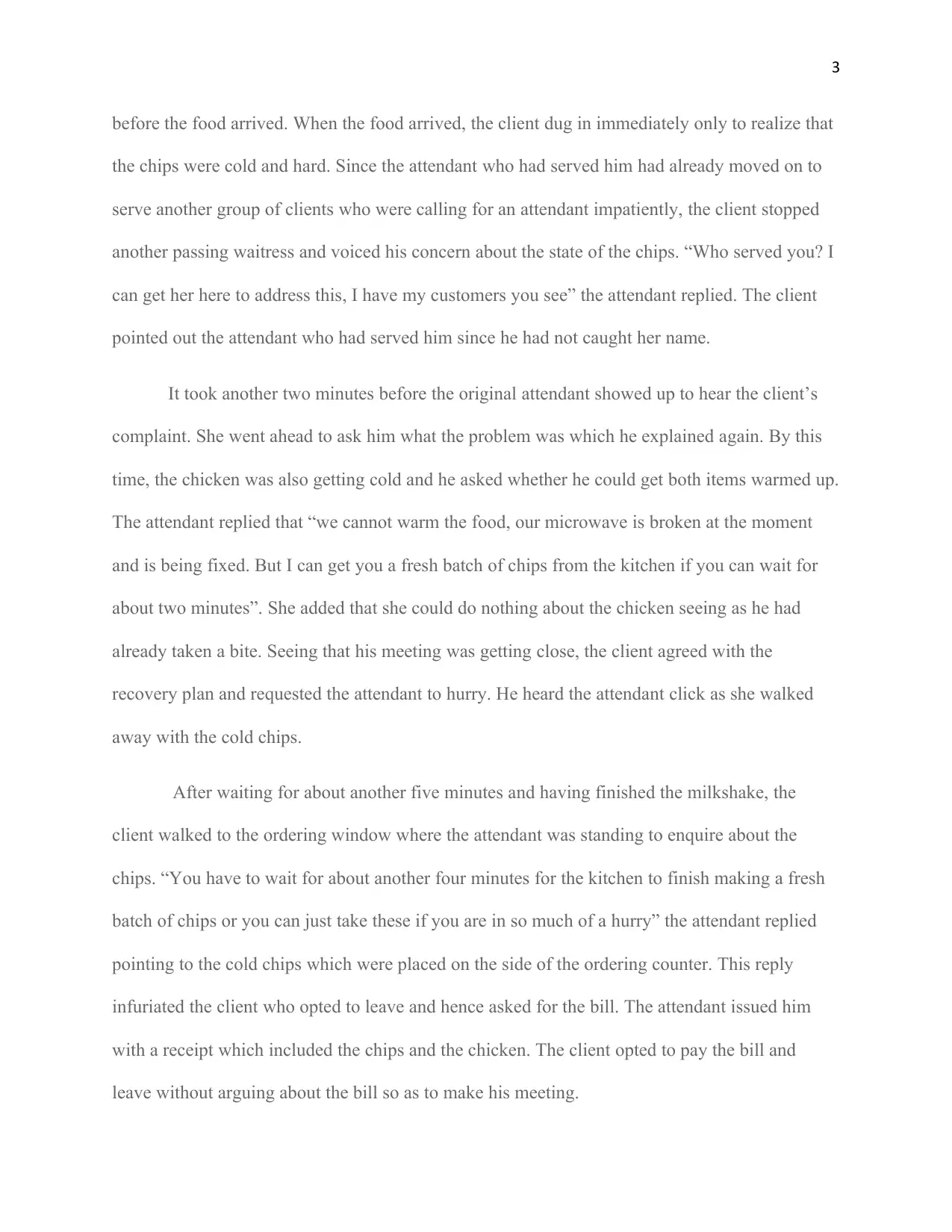
3
before the food arrived. When the food arrived, the client dug in immediately only to realize that
the chips were cold and hard. Since the attendant who had served him had already moved on to
serve another group of clients who were calling for an attendant impatiently, the client stopped
another passing waitress and voiced his concern about the state of the chips. “Who served you? I
can get her here to address this, I have my customers you see” the attendant replied. The client
pointed out the attendant who had served him since he had not caught her name.
It took another two minutes before the original attendant showed up to hear the client’s
complaint. She went ahead to ask him what the problem was which he explained again. By this
time, the chicken was also getting cold and he asked whether he could get both items warmed up.
The attendant replied that “we cannot warm the food, our microwave is broken at the moment
and is being fixed. But I can get you a fresh batch of chips from the kitchen if you can wait for
about two minutes”. She added that she could do nothing about the chicken seeing as he had
already taken a bite. Seeing that his meeting was getting close, the client agreed with the
recovery plan and requested the attendant to hurry. He heard the attendant click as she walked
away with the cold chips.
After waiting for about another five minutes and having finished the milkshake, the
client walked to the ordering window where the attendant was standing to enquire about the
chips. “You have to wait for about another four minutes for the kitchen to finish making a fresh
batch of chips or you can just take these if you are in so much of a hurry” the attendant replied
pointing to the cold chips which were placed on the side of the ordering counter. This reply
infuriated the client who opted to leave and hence asked for the bill. The attendant issued him
with a receipt which included the chips and the chicken. The client opted to pay the bill and
leave without arguing about the bill so as to make his meeting.
before the food arrived. When the food arrived, the client dug in immediately only to realize that
the chips were cold and hard. Since the attendant who had served him had already moved on to
serve another group of clients who were calling for an attendant impatiently, the client stopped
another passing waitress and voiced his concern about the state of the chips. “Who served you? I
can get her here to address this, I have my customers you see” the attendant replied. The client
pointed out the attendant who had served him since he had not caught her name.
It took another two minutes before the original attendant showed up to hear the client’s
complaint. She went ahead to ask him what the problem was which he explained again. By this
time, the chicken was also getting cold and he asked whether he could get both items warmed up.
The attendant replied that “we cannot warm the food, our microwave is broken at the moment
and is being fixed. But I can get you a fresh batch of chips from the kitchen if you can wait for
about two minutes”. She added that she could do nothing about the chicken seeing as he had
already taken a bite. Seeing that his meeting was getting close, the client agreed with the
recovery plan and requested the attendant to hurry. He heard the attendant click as she walked
away with the cold chips.
After waiting for about another five minutes and having finished the milkshake, the
client walked to the ordering window where the attendant was standing to enquire about the
chips. “You have to wait for about another four minutes for the kitchen to finish making a fresh
batch of chips or you can just take these if you are in so much of a hurry” the attendant replied
pointing to the cold chips which were placed on the side of the ordering counter. This reply
infuriated the client who opted to leave and hence asked for the bill. The attendant issued him
with a receipt which included the chips and the chicken. The client opted to pay the bill and
leave without arguing about the bill so as to make his meeting.
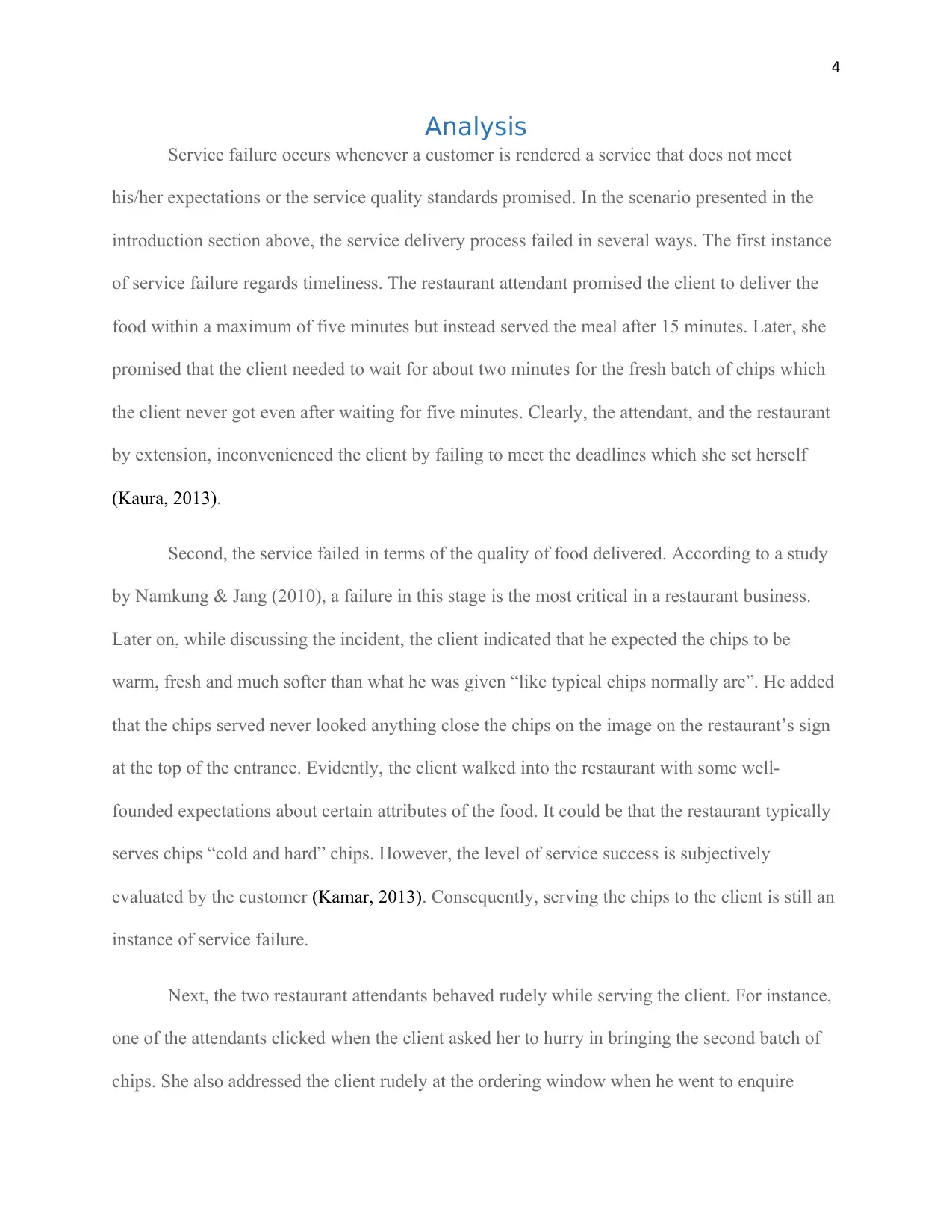
4
Analysis
Service failure occurs whenever a customer is rendered a service that does not meet
his/her expectations or the service quality standards promised. In the scenario presented in the
introduction section above, the service delivery process failed in several ways. The first instance
of service failure regards timeliness. The restaurant attendant promised the client to deliver the
food within a maximum of five minutes but instead served the meal after 15 minutes. Later, she
promised that the client needed to wait for about two minutes for the fresh batch of chips which
the client never got even after waiting for five minutes. Clearly, the attendant, and the restaurant
by extension, inconvenienced the client by failing to meet the deadlines which she set herself
(Kaura, 2013).
Second, the service failed in terms of the quality of food delivered. According to a study
by Namkung & Jang (2010), a failure in this stage is the most critical in a restaurant business.
Later on, while discussing the incident, the client indicated that he expected the chips to be
warm, fresh and much softer than what he was given “like typical chips normally are”. He added
that the chips served never looked anything close the chips on the image on the restaurant’s sign
at the top of the entrance. Evidently, the client walked into the restaurant with some well-
founded expectations about certain attributes of the food. It could be that the restaurant typically
serves chips “cold and hard” chips. However, the level of service success is subjectively
evaluated by the customer (Kamar, 2013). Consequently, serving the chips to the client is still an
instance of service failure.
Next, the two restaurant attendants behaved rudely while serving the client. For instance,
one of the attendants clicked when the client asked her to hurry in bringing the second batch of
chips. She also addressed the client rudely at the ordering window when he went to enquire
Analysis
Service failure occurs whenever a customer is rendered a service that does not meet
his/her expectations or the service quality standards promised. In the scenario presented in the
introduction section above, the service delivery process failed in several ways. The first instance
of service failure regards timeliness. The restaurant attendant promised the client to deliver the
food within a maximum of five minutes but instead served the meal after 15 minutes. Later, she
promised that the client needed to wait for about two minutes for the fresh batch of chips which
the client never got even after waiting for five minutes. Clearly, the attendant, and the restaurant
by extension, inconvenienced the client by failing to meet the deadlines which she set herself
(Kaura, 2013).
Second, the service failed in terms of the quality of food delivered. According to a study
by Namkung & Jang (2010), a failure in this stage is the most critical in a restaurant business.
Later on, while discussing the incident, the client indicated that he expected the chips to be
warm, fresh and much softer than what he was given “like typical chips normally are”. He added
that the chips served never looked anything close the chips on the image on the restaurant’s sign
at the top of the entrance. Evidently, the client walked into the restaurant with some well-
founded expectations about certain attributes of the food. It could be that the restaurant typically
serves chips “cold and hard” chips. However, the level of service success is subjectively
evaluated by the customer (Kamar, 2013). Consequently, serving the chips to the client is still an
instance of service failure.
Next, the two restaurant attendants behaved rudely while serving the client. For instance,
one of the attendants clicked when the client asked her to hurry in bringing the second batch of
chips. She also addressed the client rudely at the ordering window when he went to enquire
Secure Best Marks with AI Grader
Need help grading? Try our AI Grader for instant feedback on your assignments.
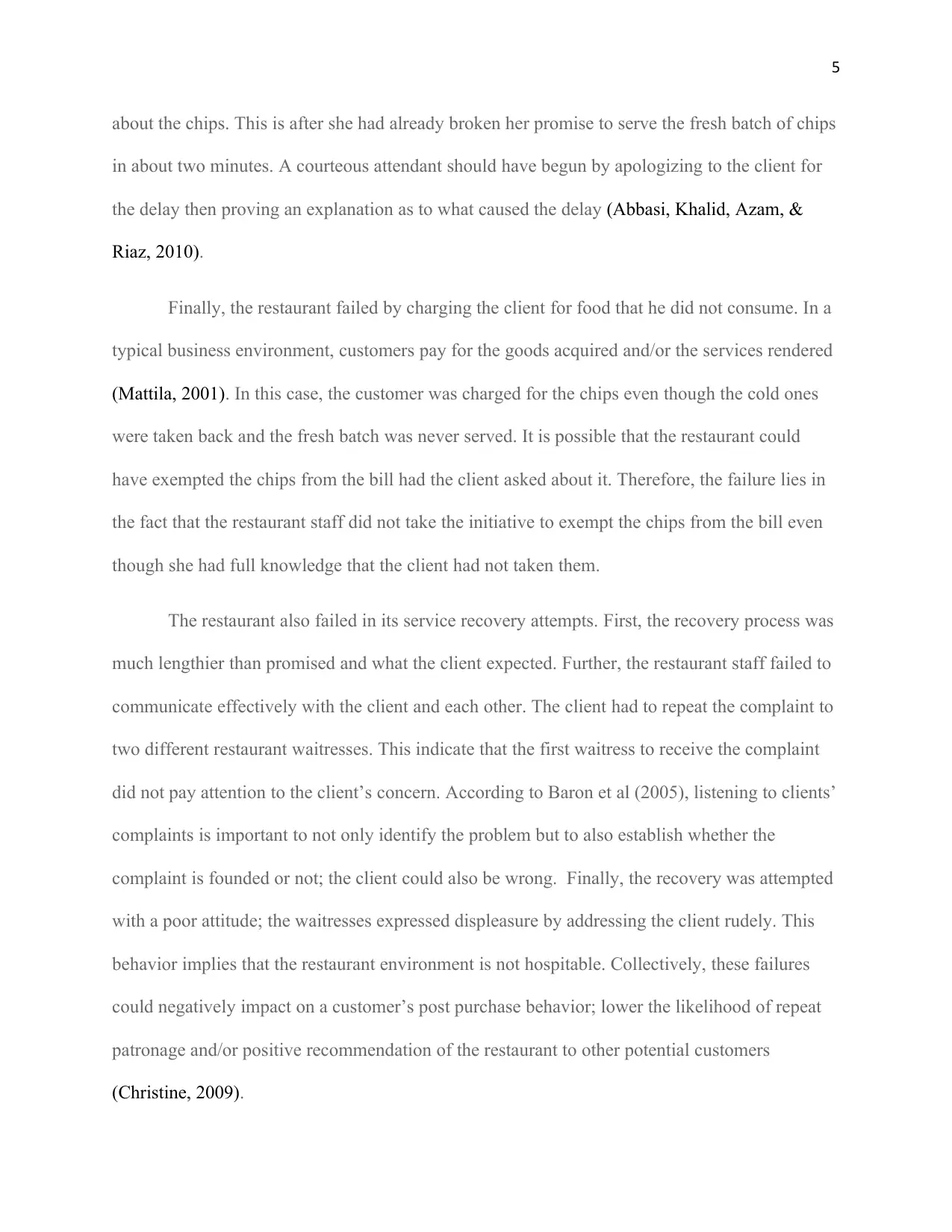
5
about the chips. This is after she had already broken her promise to serve the fresh batch of chips
in about two minutes. A courteous attendant should have begun by apologizing to the client for
the delay then proving an explanation as to what caused the delay (Abbasi, Khalid, Azam, &
Riaz, 2010).
Finally, the restaurant failed by charging the client for food that he did not consume. In a
typical business environment, customers pay for the goods acquired and/or the services rendered
(Mattila, 2001). In this case, the customer was charged for the chips even though the cold ones
were taken back and the fresh batch was never served. It is possible that the restaurant could
have exempted the chips from the bill had the client asked about it. Therefore, the failure lies in
the fact that the restaurant staff did not take the initiative to exempt the chips from the bill even
though she had full knowledge that the client had not taken them.
The restaurant also failed in its service recovery attempts. First, the recovery process was
much lengthier than promised and what the client expected. Further, the restaurant staff failed to
communicate effectively with the client and each other. The client had to repeat the complaint to
two different restaurant waitresses. This indicate that the first waitress to receive the complaint
did not pay attention to the client’s concern. According to Baron et al (2005), listening to clients’
complaints is important to not only identify the problem but to also establish whether the
complaint is founded or not; the client could also be wrong. Finally, the recovery was attempted
with a poor attitude; the waitresses expressed displeasure by addressing the client rudely. This
behavior implies that the restaurant environment is not hospitable. Collectively, these failures
could negatively impact on a customer’s post purchase behavior; lower the likelihood of repeat
patronage and/or positive recommendation of the restaurant to other potential customers
(Christine, 2009).
about the chips. This is after she had already broken her promise to serve the fresh batch of chips
in about two minutes. A courteous attendant should have begun by apologizing to the client for
the delay then proving an explanation as to what caused the delay (Abbasi, Khalid, Azam, &
Riaz, 2010).
Finally, the restaurant failed by charging the client for food that he did not consume. In a
typical business environment, customers pay for the goods acquired and/or the services rendered
(Mattila, 2001). In this case, the customer was charged for the chips even though the cold ones
were taken back and the fresh batch was never served. It is possible that the restaurant could
have exempted the chips from the bill had the client asked about it. Therefore, the failure lies in
the fact that the restaurant staff did not take the initiative to exempt the chips from the bill even
though she had full knowledge that the client had not taken them.
The restaurant also failed in its service recovery attempts. First, the recovery process was
much lengthier than promised and what the client expected. Further, the restaurant staff failed to
communicate effectively with the client and each other. The client had to repeat the complaint to
two different restaurant waitresses. This indicate that the first waitress to receive the complaint
did not pay attention to the client’s concern. According to Baron et al (2005), listening to clients’
complaints is important to not only identify the problem but to also establish whether the
complaint is founded or not; the client could also be wrong. Finally, the recovery was attempted
with a poor attitude; the waitresses expressed displeasure by addressing the client rudely. This
behavior implies that the restaurant environment is not hospitable. Collectively, these failures
could negatively impact on a customer’s post purchase behavior; lower the likelihood of repeat
patronage and/or positive recommendation of the restaurant to other potential customers
(Christine, 2009).
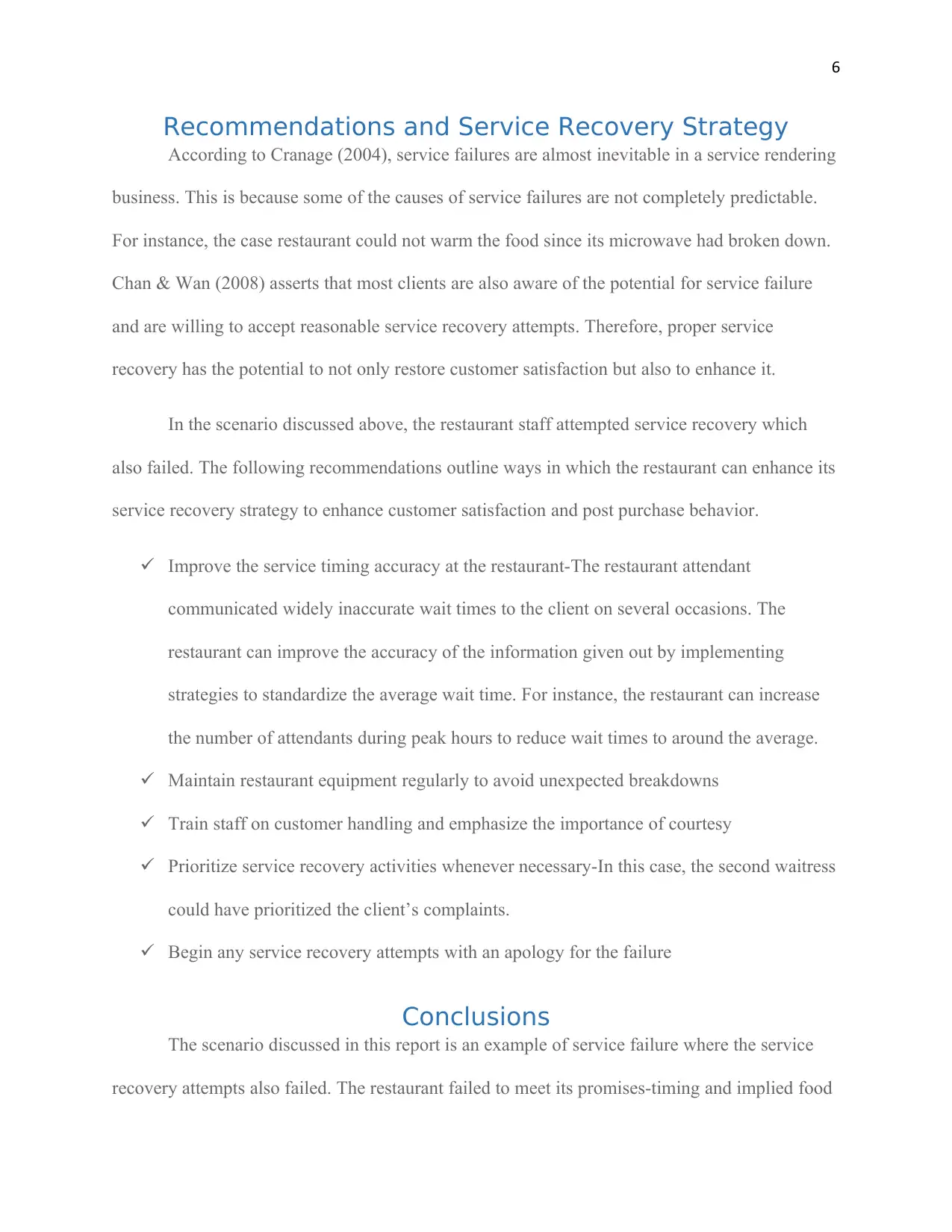
6
Recommendations and Service Recovery Strategy
According to Cranage (2004), service failures are almost inevitable in a service rendering
business. This is because some of the causes of service failures are not completely predictable.
For instance, the case restaurant could not warm the food since its microwave had broken down.
Chan & Wan (2008) asserts that most clients are also aware of the potential for service failure
and are willing to accept reasonable service recovery attempts. Therefore, proper service
recovery has the potential to not only restore customer satisfaction but also to enhance it.
In the scenario discussed above, the restaurant staff attempted service recovery which
also failed. The following recommendations outline ways in which the restaurant can enhance its
service recovery strategy to enhance customer satisfaction and post purchase behavior.
Improve the service timing accuracy at the restaurant-The restaurant attendant
communicated widely inaccurate wait times to the client on several occasions. The
restaurant can improve the accuracy of the information given out by implementing
strategies to standardize the average wait time. For instance, the restaurant can increase
the number of attendants during peak hours to reduce wait times to around the average.
Maintain restaurant equipment regularly to avoid unexpected breakdowns
Train staff on customer handling and emphasize the importance of courtesy
Prioritize service recovery activities whenever necessary-In this case, the second waitress
could have prioritized the client’s complaints.
Begin any service recovery attempts with an apology for the failure
Conclusions
The scenario discussed in this report is an example of service failure where the service
recovery attempts also failed. The restaurant failed to meet its promises-timing and implied food
Recommendations and Service Recovery Strategy
According to Cranage (2004), service failures are almost inevitable in a service rendering
business. This is because some of the causes of service failures are not completely predictable.
For instance, the case restaurant could not warm the food since its microwave had broken down.
Chan & Wan (2008) asserts that most clients are also aware of the potential for service failure
and are willing to accept reasonable service recovery attempts. Therefore, proper service
recovery has the potential to not only restore customer satisfaction but also to enhance it.
In the scenario discussed above, the restaurant staff attempted service recovery which
also failed. The following recommendations outline ways in which the restaurant can enhance its
service recovery strategy to enhance customer satisfaction and post purchase behavior.
Improve the service timing accuracy at the restaurant-The restaurant attendant
communicated widely inaccurate wait times to the client on several occasions. The
restaurant can improve the accuracy of the information given out by implementing
strategies to standardize the average wait time. For instance, the restaurant can increase
the number of attendants during peak hours to reduce wait times to around the average.
Maintain restaurant equipment regularly to avoid unexpected breakdowns
Train staff on customer handling and emphasize the importance of courtesy
Prioritize service recovery activities whenever necessary-In this case, the second waitress
could have prioritized the client’s complaints.
Begin any service recovery attempts with an apology for the failure
Conclusions
The scenario discussed in this report is an example of service failure where the service
recovery attempts also failed. The restaurant failed to meet its promises-timing and implied food
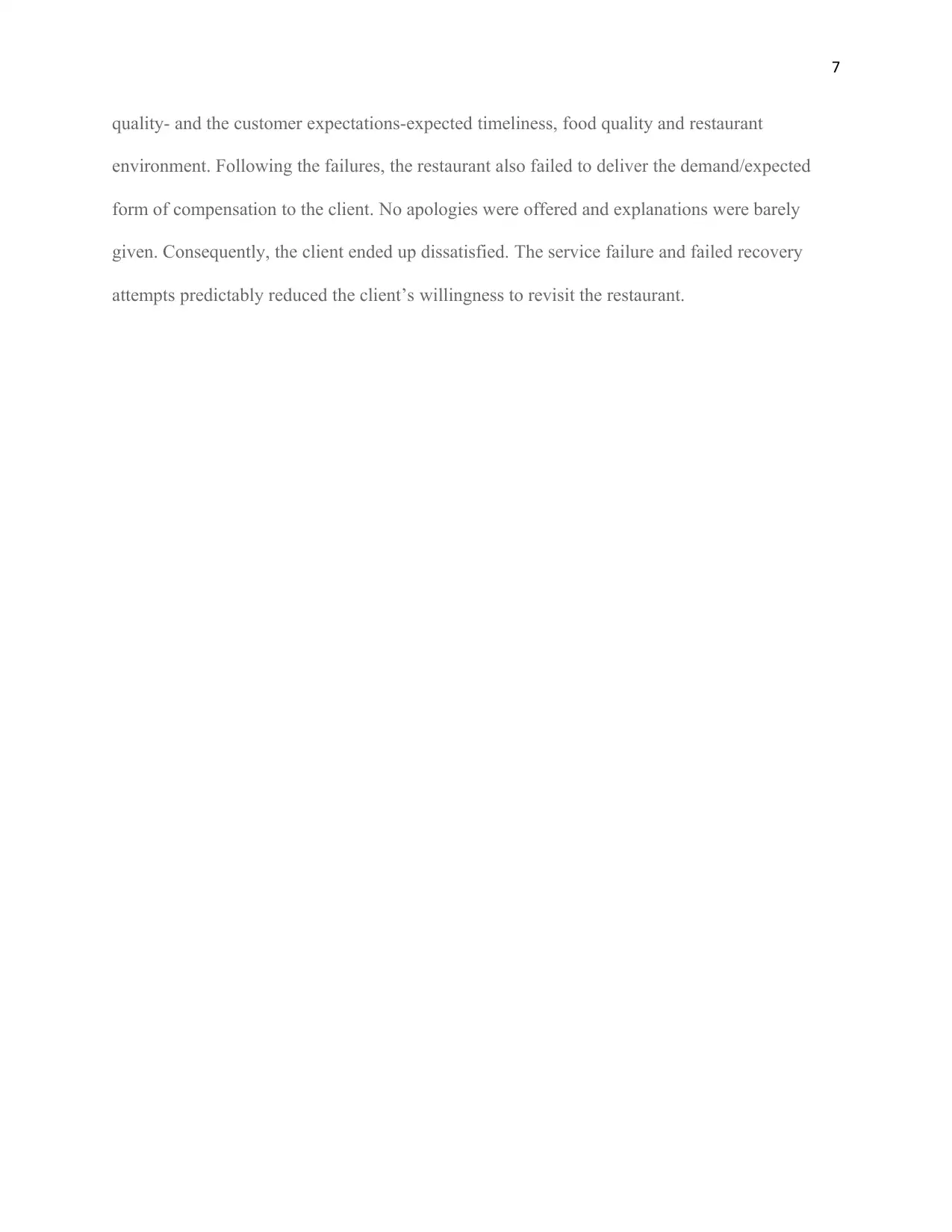
7
quality- and the customer expectations-expected timeliness, food quality and restaurant
environment. Following the failures, the restaurant also failed to deliver the demand/expected
form of compensation to the client. No apologies were offered and explanations were barely
given. Consequently, the client ended up dissatisfied. The service failure and failed recovery
attempts predictably reduced the client’s willingness to revisit the restaurant.
quality- and the customer expectations-expected timeliness, food quality and restaurant
environment. Following the failures, the restaurant also failed to deliver the demand/expected
form of compensation to the client. No apologies were offered and explanations were barely
given. Consequently, the client ended up dissatisfied. The service failure and failed recovery
attempts predictably reduced the client’s willingness to revisit the restaurant.
Paraphrase This Document
Need a fresh take? Get an instant paraphrase of this document with our AI Paraphraser
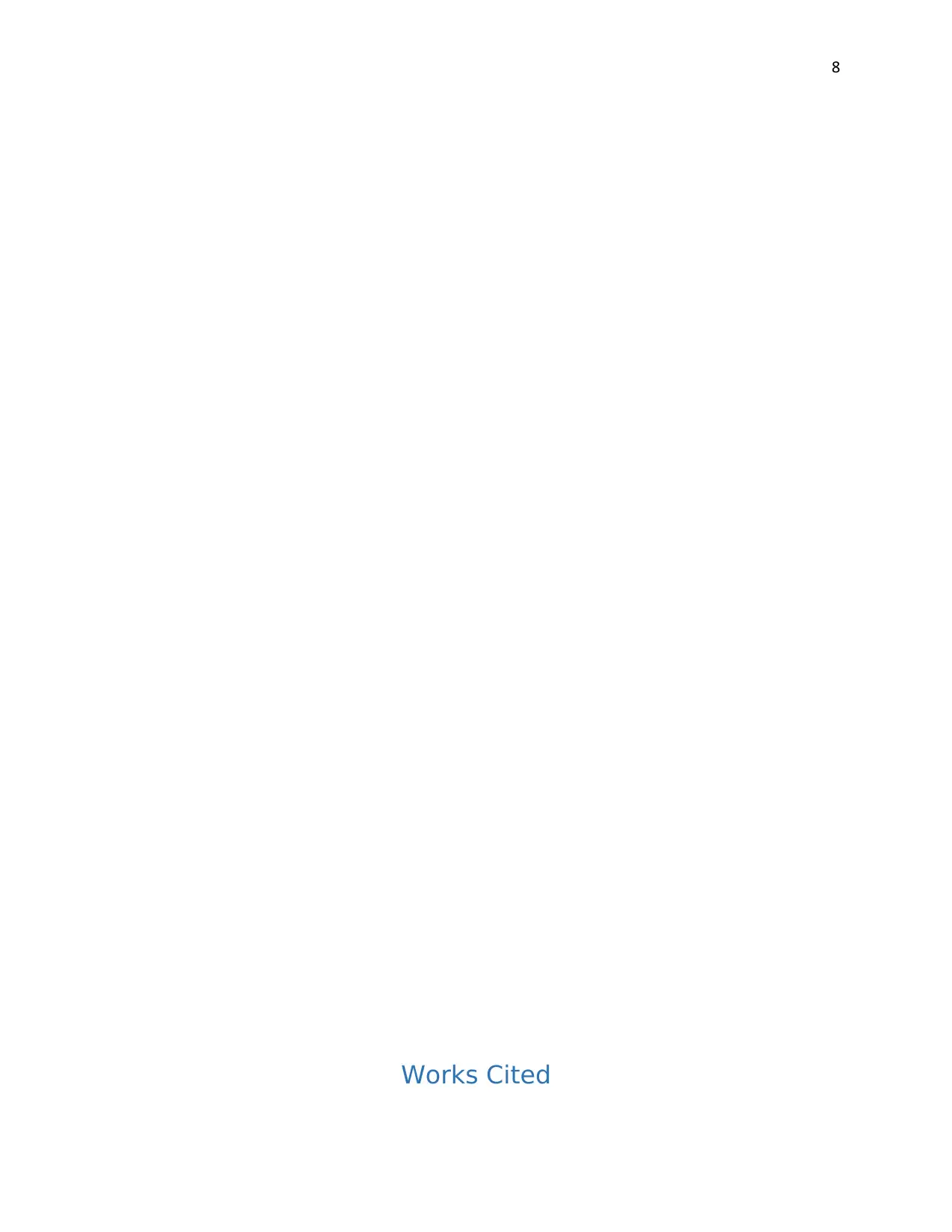
8
Works Cited
Works Cited
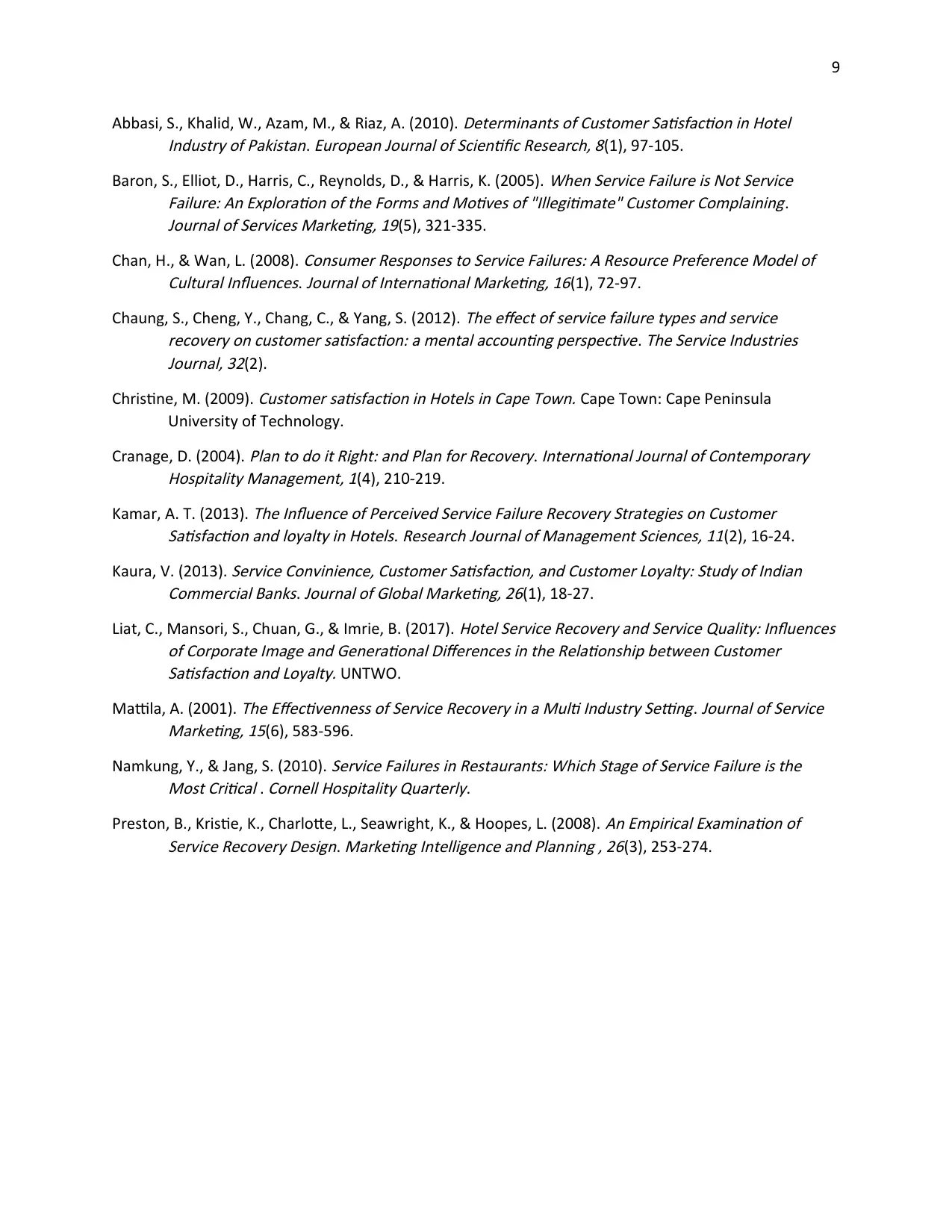
9
Abbasi, S., Khalid, W., Azam, M., & Riaz, A. (2010).
Determinants of Customer Satisfaction in Hotel
Industry of Pakistan.
European Journal of Scientific Research, 8(1), 97-105.
Baron, S., Elliot, D., Harris, C., Reynolds, D., & Harris, K. (2005).
When Service Failure is Not Service
Failure: An Exploration of the Forms and Motives of "Illegitimate" Customer Complaining.
Journal of Services Marketing, 19(5), 321-335.
Chan, H., & Wan, L. (2008).
Consumer Responses to Service Failures: A Resource Preference Model of
Cultural Influences.
Journal of International Marketing, 16(1), 72-97.
Chaung, S., Cheng, Y., Chang, C., & Yang, S. (2012).
The effect of service failure types and service
recovery on customer satisfaction: a mental accounting perspective.
The Service Industries
Journal, 32(2).
Christine, M. (2009).
Customer satisfaction in Hotels in Cape Town. Cape Town: Cape Peninsula
University of Technology.
Cranage, D. (2004).
Plan to do it Right: and Plan for Recovery.
International Journal of Contemporary
Hospitality Management, 1(4), 210-219.
Kamar, A. T. (2013).
The Influence of Perceived Service Failure Recovery Strategies on Customer
Satisfaction and loyalty in Hotels.
Research Journal of Management Sciences, 11(2), 16-24.
Kaura, V. (2013).
Service Convinience, Customer Satisfaction, and Customer Loyalty: Study of Indian
Commercial Banks.
Journal of Global Marketing, 26(1), 18-27.
Liat, C., Mansori, S., Chuan, G., & Imrie, B. (2017).
Hotel Service Recovery and Service Quality: Influences
of Corporate Image and Generational Differences in the Relationship between Customer
Satisfaction and Loyalty. UNTWO.
Mattila, A. (2001).
The Effectivenness of Service Recovery in a Multi Industry Setting.
Journal of Service
Marketing, 15(6), 583-596.
Namkung, Y., & Jang, S. (2010).
Service Failures in Restaurants: Which Stage of Service Failure is the
Most Critical .
Cornell Hospitality Quarterly.
Preston, B., Kristie, K., Charlotte, L., Seawright, K., & Hoopes, L. (2008).
An Empirical Examination of
Service Recovery Design.
Marketing Intelligence and Planning , 26(3), 253-274.
Abbasi, S., Khalid, W., Azam, M., & Riaz, A. (2010).
Determinants of Customer Satisfaction in Hotel
Industry of Pakistan.
European Journal of Scientific Research, 8(1), 97-105.
Baron, S., Elliot, D., Harris, C., Reynolds, D., & Harris, K. (2005).
When Service Failure is Not Service
Failure: An Exploration of the Forms and Motives of "Illegitimate" Customer Complaining.
Journal of Services Marketing, 19(5), 321-335.
Chan, H., & Wan, L. (2008).
Consumer Responses to Service Failures: A Resource Preference Model of
Cultural Influences.
Journal of International Marketing, 16(1), 72-97.
Chaung, S., Cheng, Y., Chang, C., & Yang, S. (2012).
The effect of service failure types and service
recovery on customer satisfaction: a mental accounting perspective.
The Service Industries
Journal, 32(2).
Christine, M. (2009).
Customer satisfaction in Hotels in Cape Town. Cape Town: Cape Peninsula
University of Technology.
Cranage, D. (2004).
Plan to do it Right: and Plan for Recovery.
International Journal of Contemporary
Hospitality Management, 1(4), 210-219.
Kamar, A. T. (2013).
The Influence of Perceived Service Failure Recovery Strategies on Customer
Satisfaction and loyalty in Hotels.
Research Journal of Management Sciences, 11(2), 16-24.
Kaura, V. (2013).
Service Convinience, Customer Satisfaction, and Customer Loyalty: Study of Indian
Commercial Banks.
Journal of Global Marketing, 26(1), 18-27.
Liat, C., Mansori, S., Chuan, G., & Imrie, B. (2017).
Hotel Service Recovery and Service Quality: Influences
of Corporate Image and Generational Differences in the Relationship between Customer
Satisfaction and Loyalty. UNTWO.
Mattila, A. (2001).
The Effectivenness of Service Recovery in a Multi Industry Setting.
Journal of Service
Marketing, 15(6), 583-596.
Namkung, Y., & Jang, S. (2010).
Service Failures in Restaurants: Which Stage of Service Failure is the
Most Critical .
Cornell Hospitality Quarterly.
Preston, B., Kristie, K., Charlotte, L., Seawright, K., & Hoopes, L. (2008).
An Empirical Examination of
Service Recovery Design.
Marketing Intelligence and Planning , 26(3), 253-274.
1 out of 9
Related Documents
Your All-in-One AI-Powered Toolkit for Academic Success.
+13062052269
info@desklib.com
Available 24*7 on WhatsApp / Email
![[object Object]](/_next/static/media/star-bottom.7253800d.svg)
Unlock your academic potential
© 2024 | Zucol Services PVT LTD | All rights reserved.



